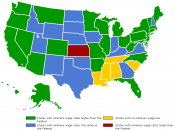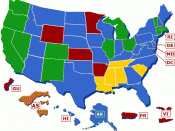What are the positive and negative effects of the national minimum wage for employees, businesses and the economy as a whole? To what extent it is advantageous?
The minimum wage was introduced in 1999and at that time was set at ã3.60. In this portfolio piece I will look at the effects it has had and finally draw my conclusions as to whether it is a good law to have.
The national minimum wage is an important cornerstone of Government strategy aimed at providing employees with decent minimum standards and fairness in the workplace. It applies to nearly all workers and sets hourly rates below which pay must not be allowed to fall. It helps business by ensuring companies will be able to compete on the basis of quality of the goods and services they provide and not on low prices based predominantly on low rates of pay. The rates set are based on the recommendations of the independent Low Pay Commission
Methodology
For this piece of portfolio work I used both primary research, where I personally collected information e.g.
an interview, and secondary research in which I took data from textbooks and the Internet. In the case of my secondary research you'll see references to the appendix unless the text is highlighted and has a reference alongside it.
Aims of the national minimum wage
*Reduce exploitation of lower paid workers
*Reduce the scale of relative poverty & inequality - direct boost to the earnings of over 1.5 million workers
*Reverse the effects of employer discrimination
*Improve incentives for people to find work and therefore reduce benefit dependency (lower welfare bill for the government)
*Expand the aggregate labour supply - helps to boost economic growth in the long term
*NMW should reduce the need for low paid workers to claim "top-up...


